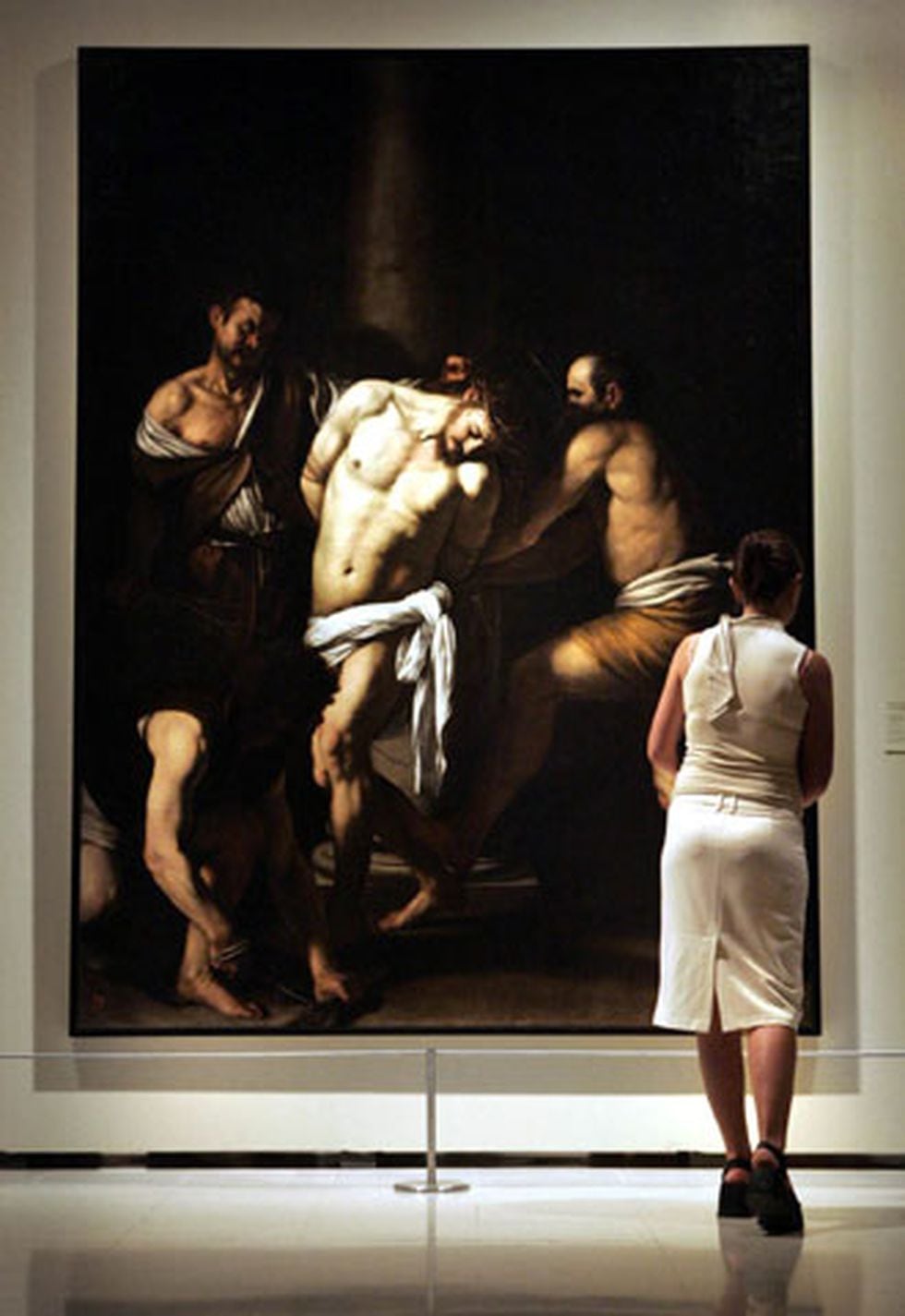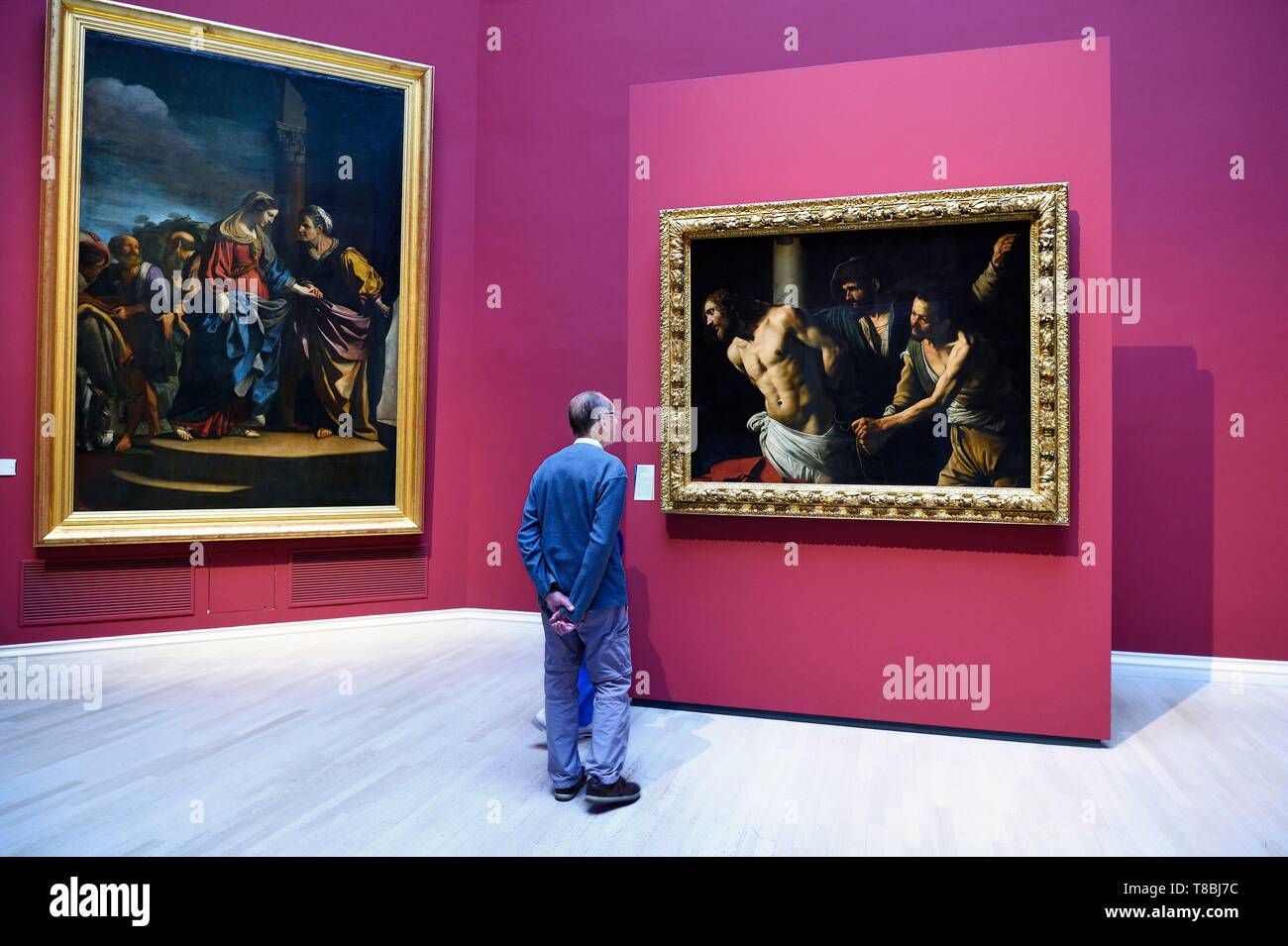
The Flagellation, or Christ at the Column / La Flagelación o Cristo atado a la Columna // 16th
La flagelación (Piero della Francesca) La "Flagelación de Cristo" (en italiano, Flagellazione di Cristo) es una pintura al temple sobre tabla de 59 x 81,5 cm, realizada probablemente entre 1468 y 1470 por el pintor italiano Piero della Francesca. Es una de sus obras más conocidas. Se conserva en la Galería Nacional de Las Marcas en Urbino.

Caravaggio The Taking of Christ, 1602. National Gallery of Ireland, Dublin. Caravaggio
Christ at the Column (also known as The Flagellation of Christ; c. 1606/1607), is a painting by the Italian Baroque painter Caravaggio, now in the Musée des Beaux-Arts de Rouen, Rouen, France. This is one of two versions of the Flagellation of Christ by Caravaggio painted late in 1606 or early in 1607, soon after his arrival in Naples. The.
CARAVAGGISMO CARAVAGGIO "LA FLAGELACION DE CRISTO"
The Flagellation of Christ (probably 1468-1470) is a painting by Piero della Francesca in the Galleria Nazionale delle Marche in Urbino, Italy.Called by one writer an "enigmatic little painting," the composition is complex and unusual, and its iconography has been the subject of widely differing theories. Kenneth Clark called The Flagellation "the greatest small painting in the world".

Art Reproduction The Flagellation of Christ Caravaggio Reproductions
La flagelación de Cristo (Caravaggio) La flagelación de Cristo es una pintura realizada por el artista italiano Caravaggio ( 1571 - 1610 ), y que en la actualidad se encuentra en el Museo de Capodimonte, Nápoles. Ha sido fechada como perteneciente a 1607, y posiblemente Caravaggio haya seguido trabajándola en 1610 .

Flagellation of Christ Caravaggio
The Flagellation of Christ, 1607 by Caravaggio. In The Flaggellation Caravaggio followed a well-established format in arranging the figures. The most influential precedent was Sebastiano del Piombo's Flagellation fresco of 1516 in San Pietro in Montorio in Rome, based on preparatory paintings by Michelangelo.Caravaggio took the fresco as his general model, and as the specific model for the.

Representations of the Flagellation
It was during his first sojourn to Naples, terminating in July 1607 that Caravaggio painted the Flagellation of Christ for the Neapolitan church of San Domenico Maggiore - the same church that displayed Titian's Annunciation (1557), now also exhibited at Capodimonte. The Flagellation entered Capodimonte in 1972 for reasons of conservation.

Flagelación (16071610), de Caravaggio Cultura EL PAÍS
ANÁLISIS FORMAL. No estamos ante un trabajo cualquiera. Hoy en La Cámara del Arte analizamos La flagelación de Cristo, el que probablemente sea el cuadro de referencia para la explicación de la composición y el tratamiento del espacio en una obra de arte. Piero della Francesca es el culpable.

"La Flagelación" di Caravaggio en el Palazzo Reale Cultura y Moda ANSA Latina
Museo di Capodimonte. The Flagellation of Christ is a painting by the Italian Baroque painter Caravaggio, now in the Museo Nazionale di Capodimonte, Naples. [1] It is dated to 1607, and may have been reworked by the artist in 1610. It is not to be confused with Christ at the Column, another Flagellation by Caravaggio of the same period.

La flagelación de Cristo Caravaggio Obra maestra Sherpa con Etsy México
La Flagellazione di Cristo è un dipinto a olio su tela (286×213 cm) di Caravaggio, realizzato tra il 1607 ed il 1608 e conservato nel Museo nazionale di Capodimonte di Napoli. [1] È considerata una delle opere più significative della maturità del pittore lombardo. [2]

Reproducción La flagelación de Cristo Caravaggio Pintores famosos
La Flagellation du Christ (en italien : Flagellazione di Cristo) est une peinture à l'huile sur toile du peintre italien Le Caravage, peint probablement en 1607 [1] et conservé au musée de Capodimonte de Naples en Italie.Le même sujet est représenté dans le tableau Le Christ à la colonne (1607) conservé au musée des Beaux-Arts de Rouen.. Elle est considérée comme l'une des œuvres.

Reproducción La flagelación de Cristo Caravaggio Pintores famosos
Size of this preview: 449 × 599 pixels. Other resolutions: 180 × 240 pixels | 360 × 480 pixels | 575 × 768 pixels | 767 × 1,024 pixels | 1,907 × 2,545 pixels. This is a faithful photographic reproduction of a two-dimensional, work of art. The work of art itself is in the public domain for the following reason:

The Taking of Christ / Caravaggio Caravaggio, Arte barroca, Arte renascentista
The Flagellation of Christ is a painting by the Italian Baroque painter Caravaggio, now in the Museo Nazionale di Capodimonte, Naples. It is dated to 1607, and may have been reworked by the artist in 1610. It is not to be confused with Christ at the Column, another Flagellation by Caravaggio of the same period..

Francia, Seine Maritime, Rouen, Museo de Bellas Artes, la pintura La Flagelación de Cristo en la
El Contexto Religioso. La Flagelación de Cristo es una escena que representa el momento en el que Jesús es azotado y maltratado antes de su crucifixión. Este episodio es fundamental en la narrativa de la Pasión de Cristo, un componente central en la teología cristiana que simboliza el sacrificio de Jesús por la redención de la humanidad.

The Flagellation Of Christ, Detail Acrylic Print by Caravaggio
"La flagelación de Cristo" de Caravaggio es mucho más que una simple pintura religiosa. Es una representación poderosa y visceral del sufrimiento y sacrificio de Cristo, que resuena en el espectador incluso después de tantos siglos. Esta obra maestra no solo marca un punto de inflexión en la carrera de Caravaggio, sino que también ha.

Lienzo Tela La Flagelación De Cristo Arte Sacro Caravaggio 750.00 en Mercado Libre
La iconografía particularmente dramática y cruel de la flagelación de Cristo está muy extendida y muchos artistas, de los menores a los mayores, se han medido con ella, baste pensar en Piero della Francesca, hasta Bramante y Caravaggio. Michelangelo Merisi, conocido como Caravaggio, Flagelación de Cristo (1606-1607) , Museo de Bellas Artes.

Pin on Gesù
Caravaggio. La captura de Cristo, El prendimiento de Cristo o El beso de Judas es una pintura realizada aproximadamente en 1602 por el artista barroco italiano Michelangelo Merisi da Caravaggio. La obra se encuentra en la Galería Nacional de Irlanda, en Dublín. En la pintura pueden observarse siete figuras; estas son, de izquierda a derecha.